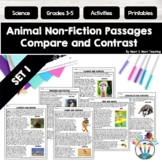183 results
Free 12th grade earth sciences laboratories
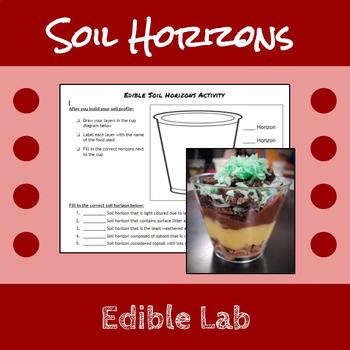
Edible Soil Horizon Activity (APES)
Students use chocolate & vanilla pudding, oreo cookies, gummy worms, and shredded coconut to create dirt cups that show the soil horizons (O, A, E, B, C). Students then answer questions relating to each soil horizon.
Subjects:
Grades:
9th - 12th
Types:

LAB - Nightmare Land Contour Map
******UPDATED 1/15/16******
This activity is one of my students favorites! I usually use this as a review of contour lines. Topics addressed in this are contour interval, steep slopes, gentle slopes, compass direction, highest possible elevations, measuring distance using a map scale, the direction of river flow, calculating gradient, and constructing profiles.
I created this digital version of Nightmare Land based on a hand-drawn copy I received from a colleague a few years ago. I also added
Grades:
8th - 12th
Types:

Soil Permeability and Porosity Lab -- Three Versions
This product I am offering is a single download that includes three versions of the same soil permeability and porosity lab; one is a coobook version, another is a higher-level inquiry version, and the last is a science notebook inquiry version.
You can get more information about this lab, as well as photographs at my website:
http://www.stemmom.org/2012/12/soil-permeability-and-porosity-lab.html
Cookbook Version of the Soil Permeability and Porosity Lab
The cookbook version of this soil
Grades:
9th - 12th, Higher Education
Types:

Plate Boundaries of the World Lab
This is an earth science lab activity students of all levels can complete! During this three day lab, students will color a plate map of the world and use this map to figure out what type of plate boundary locations such as Japan, Philippines, Malaysia, Red Sea, Himalayas, etc would be located along.
Students will also have to label the types of geologic features would be associated with each and determine whether the volcanoes would be explosive or non-explosive.
I have done this lab with st
Subjects:
Grades:
9th - 12th, Higher Education
Types:
Also included in: AP Environmental Science
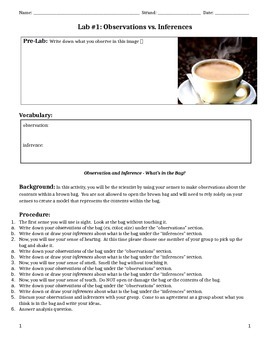
Lab #1: Observations vs. Inferences
Lab #1 of my Lab Series.In this lab students practice using their 5 senses (except for taste) to make a series of observations of a brown paper bag (the mystery bag). The goal is for students to use their observations to make an inference as to what is inside of the mystery bag and then relate their experience to the work scientists do. I have used this activity with great success to start off the school year. This lab is applicable to any type of science course, not just Earth Science. This lab
Subjects:
Grades:
7th - 12th, Higher Education
Types:
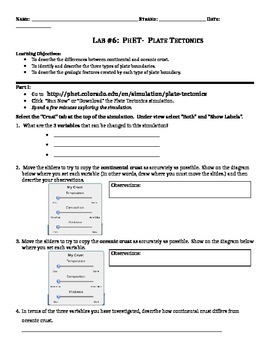
Lab #6: PhET Plate Tectonics
Lab #6 in my lab series.NOTE: This lab requires access to a computer and the PhET Plate Tectonics Simulation Website.Students use the PhET Plate Tectonics Simulation to describe the differences between continental and oceanic crust, to identify and describe the three types of plate boundaries, and to describe the geologic features created by each type of plate boundary.I have had great success with this lab. My students enjoyed using the simulation and by having them draw time-lapse sketches of
Subjects:
Grades:
7th - 12th, Higher Education, Adult Education
Types:
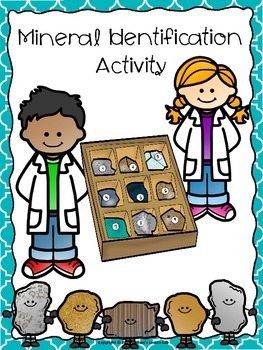
Mineral Identification Worksheet
This product includes a chart for students to fill in, and a chart of the information about the minerals (to be used to help students identify each mineral) sorted by hardness. This is designed to be used with a kit of 15 minerals including:
★Talc
★Graphite
★Satin Spar
★Alabaster
★Selenite
★Halite
★Muscovite
★Biotite
★Calcite
★Fluorite
★Hematite
★Feldspar (microline)
★Magnetite
★Pyrite
★Milky quartz
I have included a link in the product to purchase this set of minerals if you don't have them a
Grades:
6th - 12th
Types:
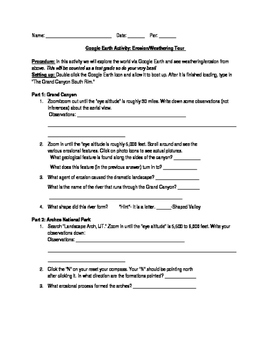
Google Earth Activity: Weathering, Erosion and Deposition
In this activity students will explore the Earth and Mars and locate depositional features. This lesson takes roughly 80 minutes.
Subjects:
Grades:
8th - 12th
Types:
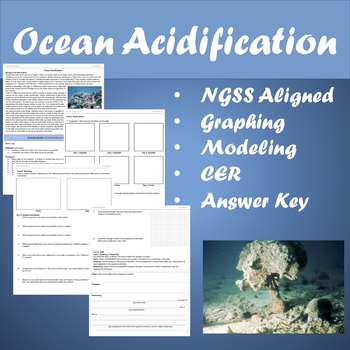
Ocean Acidification Experiment
Ocean Acidification is a 4 page Claim - Evidence - Reasoning (CER) lab design used to support students critical thinking, problem solving skills, and NGSS skills. Students use seashells and chalk to represent coral reefs and vinegar to represent ocean acidification. Students observe, model, research, make a claim, provide evidence, and reasoning for the experiment. Lab takes 3 days to really see the results but can take longer to further see the effects of acids on calcium carbonate. Includes an
Subjects:
Grades:
9th - 12th
Types:
NGSS:
HS-ESS2-6
, HS-ESS2-2

Lab #7: Mineral Identification
Lab #7 in my Lab SeriesMineral Identification LabIncludes Pre-Lab in which students identify the lab materials (i.e. streak plate, glass plate, nail, penny, magnifying glass)Includes Clear Directions how to complete each mineral test.Includes a photograph image to aide students in identifying the mineral samples. (If your available mineral samples are different, you can easily replace my images with your own.) My lab images: 1. Galena 2. Magnetite 3. Biotite Mica 4. Sulfur 5. Pyrite 6. Muscovite
Subjects:
Grades:
6th - 12th, Higher Education
Types:
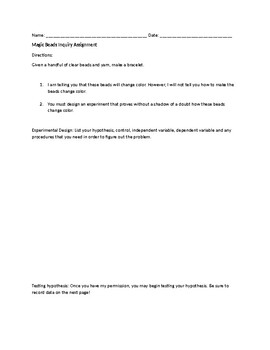
UV Bead Inquiry Lab (Electromagnetic Spectrum)
This is an inquiry based lab using UV beads to explore the EM Spectrum. It has an extension built in to test how sunscreens protect our skin from UV-A and UV-B light. Students must design their own experiments, and are encouraged to try as many EM Spectrum waves as possible.
Subjects:
Grades:
9th - 12th
Types:
NGSS:
HS-PS4-4
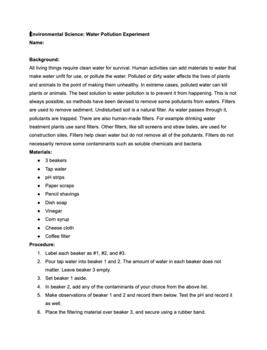
Water Pollution Quick Lab
This is a lab that demonstrates water pollution and the quality of drinkable water in less than one class period. It can be easily adjusted based on the products you already have on hand. Students will compare the look, feel, smell and pH of normal tap water, "polluted" water, and "filtered" water.
Subjects:
Grades:
7th - 12th
Types:
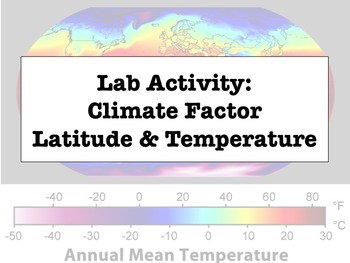
LAB - Latitude & Temperature (w/ PowerPoint)
In this lab, students will analyze the relationship between latitude and temperature.
Students will:
- Plot the latitude and longitude of 4 cities on a map,
- Make predictions about average annual temperature,
- Make predictions about average temperature range,
- Construct line graphs of monthly temperatures for 4 cities,
- Analyze temperature graphs.
A PowerPoint with an answer key is included.
--*--*--*--*--*--*--*--*--
MY CLIMATE LABS
Latitude and Temperature (w/ PowerPoint) *FREEBI
Grades:
8th - 12th
Types:

Periodic Table a Chemistry Reference
Best for color printing on 8.5x11 in paper in Landscape setting.
Color Periodic table depicting a differentiation of element's natural state at 298 K.
The element names as well as the spellings of the lanthanide and actinide series follow conventions in the United States of America. The group designations of 1 through 18 follow the current convention of the International
Union of Pure and Applied Chemistry (IUPAC); the IA through VIIIA labels used in the United States are included for historica
Subjects:
Grades:
PreK - 12th, Higher Education, Adult Education
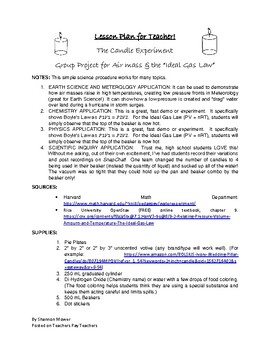
The Candle Experiment - The Ideal Gas Law Demonstration & Experiments
This is a lesson plan and 2 student write up files for doing demonstrations and experiments using the Ideal Gas Law. It has multiple applications and uses: 1. EARTH SCIENCE AND METEROLOGY APPLICATION: It can be used to demonstrate how air masses raise in high temperatures, creating low pressure fronts in meterology (great for Earth Science!) It can show how a low pressure is created and “drag” water over land during a hurricane in storm surges.2. CHEMISTRY APPLICATION: This is a great, fast de
Subjects:
Grades:
7th - 12th
Types:
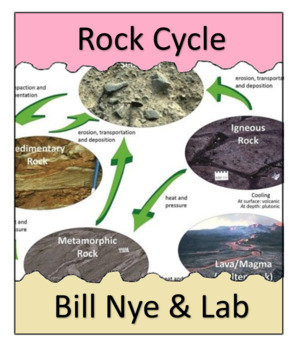
Rock Cycle
What is the rock cycle? In this lesson students will develop a deeper understanding of the rock cycle by watching a Bill Nye the Science Guy video and by using Starburst candy to recreate a model of the rock cycle. Please feel free to review and provide feedback for us to improve and create new resources for you.
Subjects:
Grades:
3rd - 12th
Types:

Layers of the Earth Full Lesson & Lab
Layers of the Earth Lesson plan including slides, Scaffolded notes, and a Lab Activity. This is lesson 1 of Unit 1: Cause and Effects of EarthquakesRelated Products: Lessons in this Unit1 - Layers of the Earth (THIS LESSON)2 - Plate Types and Boundaries3 - Density and Convection4 - Seafloor Spreading5 - Earthquakes: Waves and Locations6 - Measuring Earthquakes
Subjects:
Grades:
9th - 12th
NGSS:
HS-ESS2-3
, HS-ESS2-1
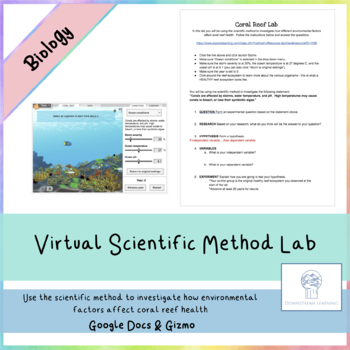
Investigate Coral Reefs Using the Scientific Method: GIZMO Activity
This worksheet corresponds to the Coral Reefs: Abiotic Factors Gizmo (license required). It uses the coral reef simulation to have students investigate how changing environmental factors affect the reef. Throughout the virtual lab, students create their own hypothesis and use the steps of the scientific method to gather data. Students also become familiar with reef biology and abiotic factors in the environment. This product includes:Student worksheet - Google DocsTopics covered include:Step
Subjects:
Grades:
7th - 12th
Types:
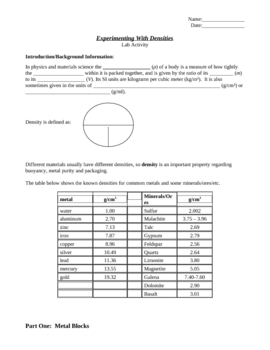
Density of Solids and Liquids Lab
In this 11 page, three part, hands-on activity, students will calculate density using the different lab techniques and tools. They will use volumetric displacement, a triple-beam balance, and basic measurement to calculate volume of a geometric shape. This is an excellent activity to demonstrate two simple ways to measure volume, and compare results. Density is then used as a property to identify an unknown metal bar. Later, they use samples of rocks/ores/minerals. Lastly, they experiment wi
Grades:
7th - 12th
Types:
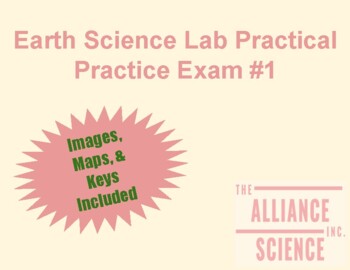
NYS Regents Earth Science Practical Lab Exam Practice #1
This Earth Science Lab Practical Exam (NYS) will allow you and your students to assess how prepared they are for the real thing while maintaining the integrity of the real exam. Earth Science Practical Lab Exam Practice #1For Earth Science Practical Lab Exam Practice #2Included are practice stations (1-3) Necessary images for rocks/minerals characteristicsFlowcharts for mineralsEarthquake seismograph print outsEpicenter Practice Map with a legendEccentricity (drawn & labeled ellipse as well
Subjects:
Grades:
7th - 12th
Types:
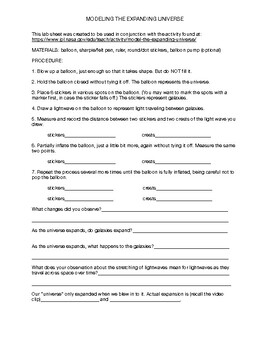
Modeling the Expanding Universe
This activity/lab sheet was created to be used in conjunction with the activity found at https://www.jpl.nasa.gov/edu/teach/activity/model-the-expanding-universe/ : Students learn about dark matter and dark energy, as well as the role they play in the expansion of the universe. Then, they will model the expanding universe using balloons.
Subjects:
Grades:
6th - 12th
Types:

Fossil Lab LITE
This video features the Full Version of the Fossil LabFossil Lab demo VIDEOThe Fossil Lab LITE is a free, limited version of the full version Fossil Lab. This LITE version works just like the full version but limits you to 5 of the 28 lab stations. All of the reference pages are available in the LITE version but the Student activity pages are not included in the LITE version.The Fossil Lab introduces the concept of fossilization and helps students understand the various ways in which fossils can
Subjects:
Grades:
5th - 12th
Types:

Barycenter Lab
This is a barycenter lab that can be used to help students understand the concept of barycenter better. Materials used are string, wooden pole/dowel (a pencil will work), tape, playdoh, scale, and tape measure. There are post-lab questions that follow and a place for students to make their own graph.
Subjects:
Grades:
6th - 12th
Types:
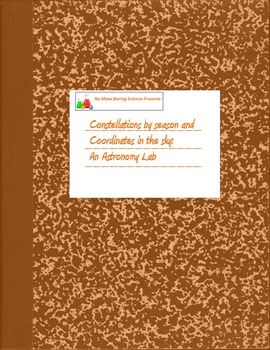
FREE Astronomy/Earth Science Lab Activity - Constellations by Seasons
New from No More Boring Science - Coordinates of stars and Constellations by season! Two activities included! Kids practice plotting stars on a Mercator map projection and a polar map projection given a set of coordinates. Great for practicing their math or geography skills! Then, students study seasonal star maps to identify constellations present at different seasons! Keys are included as well!
If you like the activity, be sure to rate it!
This is part of a series of activites on Science in
Subjects:
Grades:
7th - 12th, Higher Education, Adult Education
Types:
Showing 1-24 of 183 results




